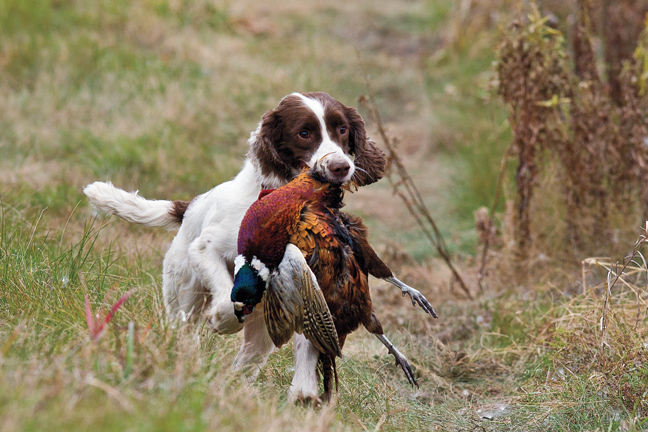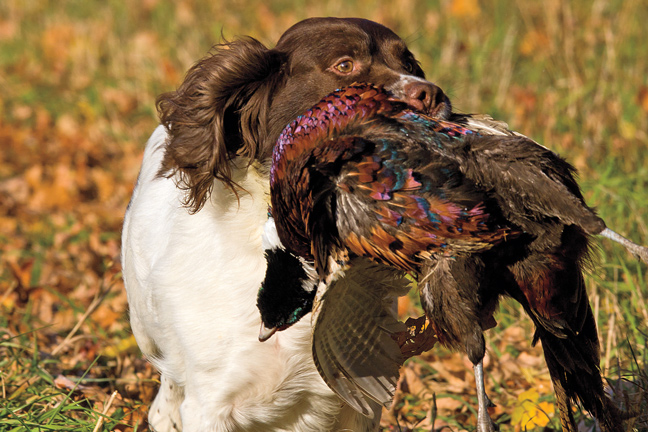With bird season on the horizon it's time to teach pup, or review with our trained dog, hand signals to fallen birds they did not see go down.
In situations where pup scents a bird, tracks and flushes it, he usually marks its fall and is able to retrieve it whether he is steady or not. A standard pheasant hunting scenario, no dog does it better than an English springer spaniel.
Often, though, pup pushes a bird and it flushes from the opposite side of a hedgerow or excessively heavy cover where he is unable to see the flush or mark the bird's fall. So he needs our assistance.
Ruffed grouse hunting, for example, provides multiple unseen flushes, making marking impossible for pup. Additionally, in the upcoming dove season there are a myriad of cases where pup does not see a bird shot.
Hunting birds with a gun dog is a partnership, and while pup normally does the bulk of the real work, he occasionally needs help, and it starts with training him properly. Pup must be retrieving enthusiastically and reliably, and sitting on the whistle, to learn the hand signals that will direct him.
Using hand signals for dogs is all about repetition, but it's relatively easy to teach pup to take directions to fallen birds. Additionally, pup is rewarded every time he takes your directions (hand signals) by having a bird or dummy to retrieve.
The standard flushing dog training scenario has you and two guns/assistants about 15 yards to each side of you in a training field with pigeons in your vests to plant or toss for pup. The normal drill is to walk down the field with pup quartering ahead of you, and birds are tossed into cover so that pup does not see them. (Or, birds can be pre-planted.) Flushed birds are shot and pup retrieves the birds to you. Alternatively, dead birds can be tossed to retrieve.
If this is your regular training field, paths have generally been beaten into the cover, marking where the handler and his two guns/assistants walk. Your "path" enables pup to learn this drill easily by giving him an easy path to follow.
Setting the Stage
The easiest way to train pup to take a straight line to an unseen fall is to begin at the end of a bird flushing and retrieving drill that puts you a fair distance down the training field and you're ready to walk him back to the staging area.
Have pup hup (sit) and send your two "guns" back to the truck so pup is not distracted by their presence. If pup is young and this is his first time, or if he is not heeling reliably when you head back to the training area, snap a leash on him.

Take either a dead pigeon or a retrieving dummy and drop it on the path you have just walked while working pup. Pup sees the pigeon and wants to retrieve it, but do not allow him to — yet. Walk pup about 20 yards back toward the staging area and have him sit facing you with his back towards the dropped pigeon.
Pause and make sure pup remains sitting, then detach his leash if necessary. Point behind pup with one hand, at the same time commanding "Back!" Pup should take off like a rocket and be guided by the path to the pigeon. Already a reliable retriever, pup will pick the pigeon up and return to you immediately. Accept the bird and praise pup with a pat on the head and an atta-boy.
If you do not have a regular training area with worn paths, walk only about 10 yards before sending pup back for the pigeon. Repeat this drill two or three times a training session, and increase the distance gradually over time, being sure pup stays on track.
Within two or three months you should be able to sit pup in front of you and send him "back" for a pigeon or bird he did not see fall; return to using short distances.
Hide a dead pigeon behind a small piece of cover about 10-15 yards away from the spot you send pup from when you first attempt this. Be sure to use the hand signal with the verbal command "back." It is important that pup is successful each time he is sent for a bird he did not see fall.
Gradually increase the distance pup must go to retrieve the unseen bird. Later, make some of these blind retrieves at least 50 yards.
Field trial retrievers make incredibly long retrieves, including "blind" retrieves. After rigorous training some seem as though they could take a "line" towards a blind retrieve until they reach the edge of the earth. It is impressive and a necessity for retriever breeds in the field. Not so for spaniels. On any blind retrieve nearing or over 50 yards I walk my spaniel at least halfway to the fall, likely even closer. It is quicker and easier, and less likely to cause pup to fail.
Enthusiasm Afield
Often I take a live pigeon or two and a fresh dead pigeon when I go bird hunting. If pup has hunted hard for a couple of hours without a flush I dizzy and plant (where it is legal) a live pigeon for him to find and flush — hopefully I come through and shoot the bird so he gets a retrieve. It's a good way to keep pup enthusiastic.
The dead pigeon is for the occasional scenario when pup works hard but still cannot find a downed bird. When I am sure it is a lost bird I will drop the dead pigeon without pup seeing me to ensure that he finds the bird, thus "making" the retrieve and keeping pup enthusiastic.

Another reason I walk my spaniel partway to a long blind retrieve is that well-bred spaniels are hard-wired to quarter their ground when hunting. I am not saying spaniels cannot learn to take a long line or be directed in the field. I am saying that it goes against their natural and preferable instincts.
Generally speaking, in springer spaniel field trials in the U.S. judges do not like to see a lot of handling, and tend not to reward it, even if it results in a retrieve. If a springer needs a lot of handling to a retrieve the dog is often marked down by the judges for not marking or retrieving well.
I have seen examples in field trials, hunt tests and in the hunting field when an excessive amount of handling was necessary to find a downed bird. It isn't pretty, at least in my eyes.
My preference in such situations is to walk pup closer to the fall, give him a line and send him from a much shorter distance. Problem solved, bird delivered.
I gunned a fun water trial for springer spaniels years ago in New Jersey where one dog had trouble finding a dead bird on the water. I do not remember if it was a blind or one-half of a double retrieve. The dog was unable to find the bird and the dog's owner tried several times to use hand signals to direct his dog to the dead bird.
It was obvious the dog was confused and unlikely to find the bird quickly. The owner recognized the dog's plight and whistled him in to stop him from competing, saying, "This dog is a field champion, and I'm not letting him look bad."
Amen to that, and I'm not letting my dogs look bad either when I can simply walk them closer to the downed bird.






